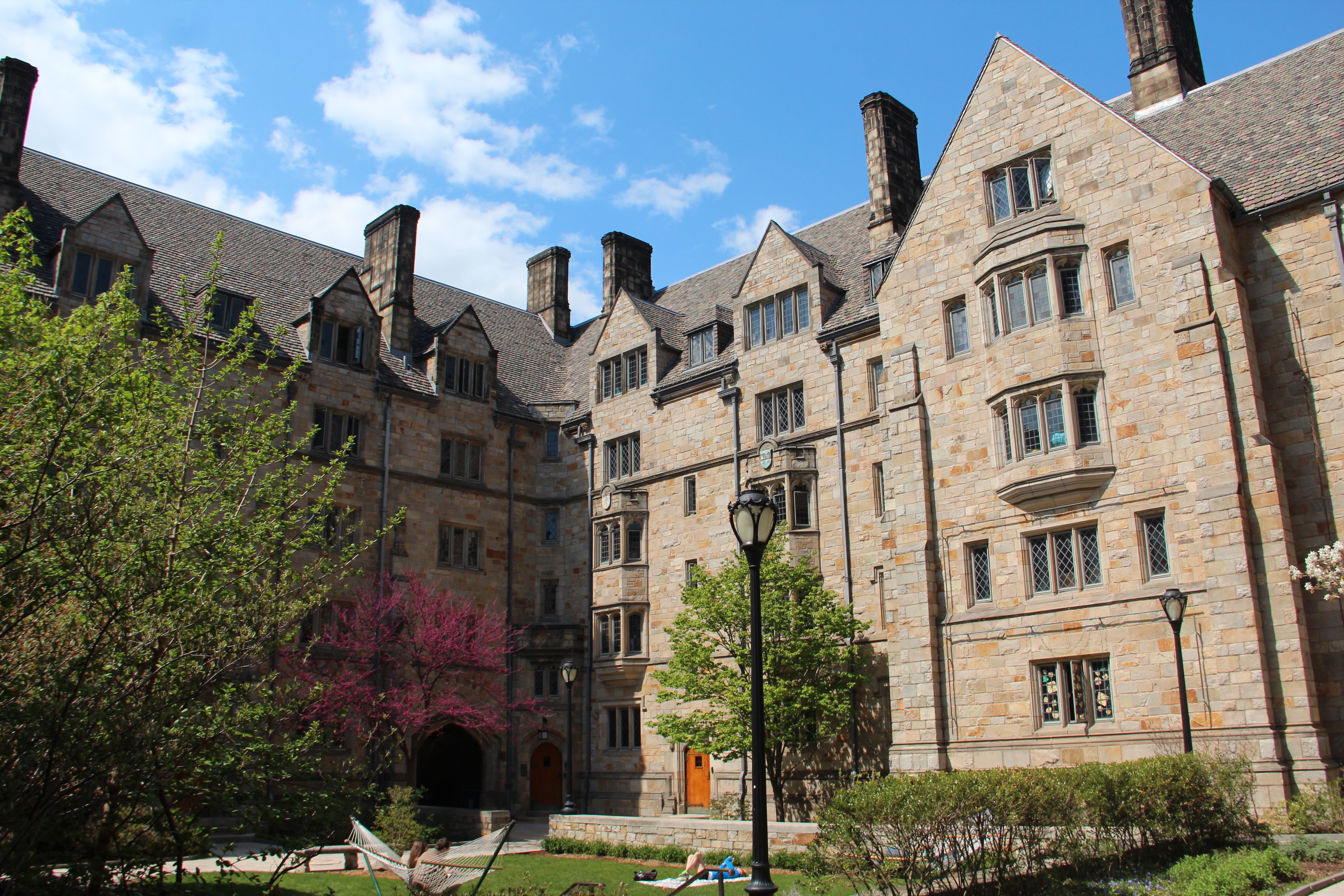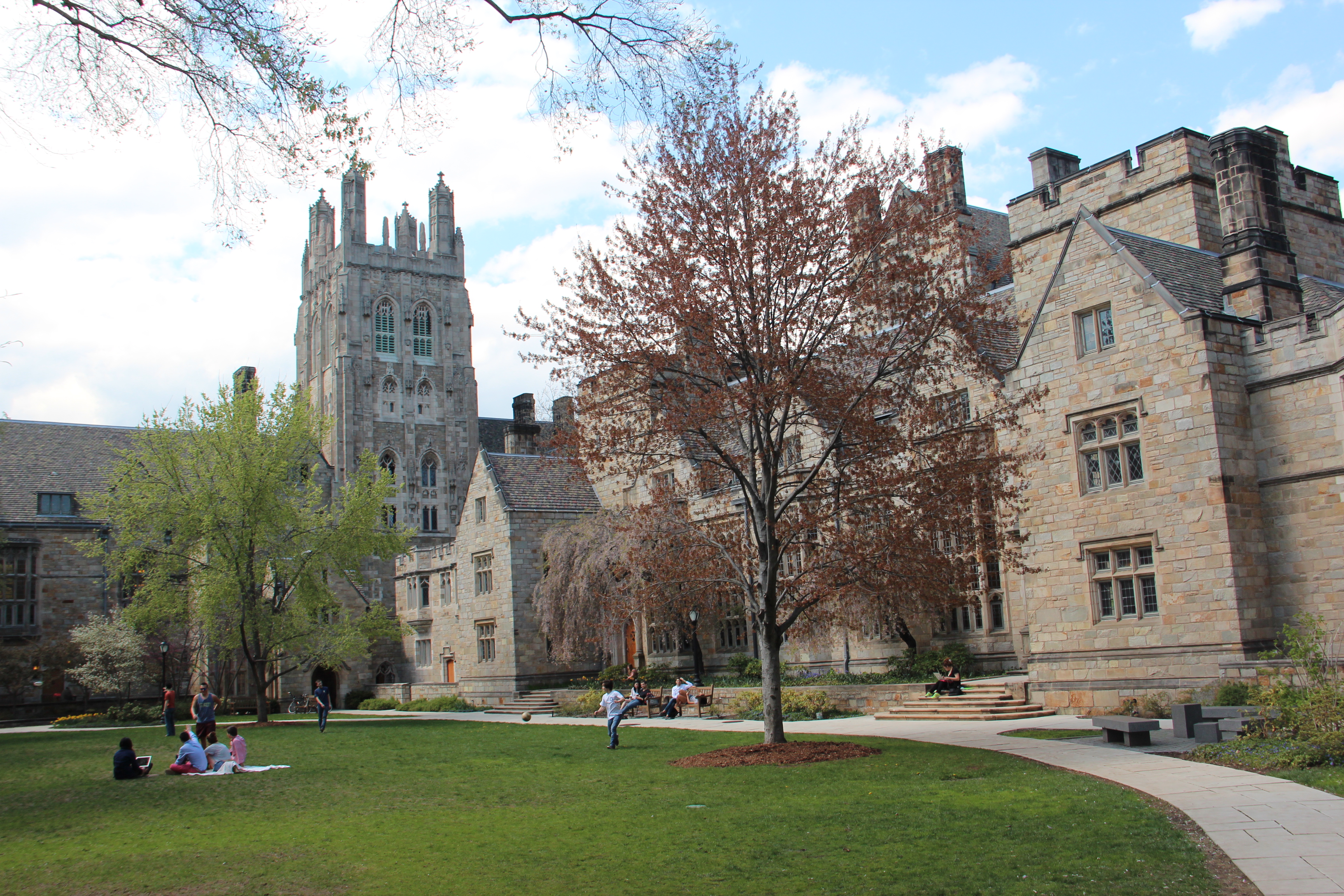Memorial Quadrangle on:
[Wikipedia]
[Google]
[Amazon]
 The Memorial Quadrangle is a residential quadrangle at
The Memorial Quadrangle is a residential quadrangle at
 Construction began in 1917, the bicentennial of Yale's first building in New Haven, and was completed in 1921. As initially built, the Quadrangle contained dorm rooms for 630 students, a dining hall, and seven courtyards. Dry
Construction began in 1917, the bicentennial of Yale's first building in New Haven, and was completed in 1921. As initially built, the Quadrangle contained dorm rooms for 630 students, a dining hall, and seven courtyards. Dry
 From 1921 to 1929 the building housed Yale College seniors. In 1928, a donation from Edward Harkness began Yale's residential college system, the buildings of which were also planned and designed by Rogers. Rogers split the Quadrangle into two residential colleges—Saybrook and Branford, so named for the courtyards they contain—and added mid-sized elements such as masters' houses, fellow's quarters, and dining halls. During the conversion, the "Gold Coast" of student rooms in the middle of the Quadrangle was hollowed out to make way for the Saybrook College dining hall. The colleges opened on September 25, 1933.
From 1921 to 1929 the building housed Yale College seniors. In 1928, a donation from Edward Harkness began Yale's residential college system, the buildings of which were also planned and designed by Rogers. Rogers split the Quadrangle into two residential colleges—Saybrook and Branford, so named for the courtyards they contain—and added mid-sized elements such as masters' houses, fellow's quarters, and dining halls. During the conversion, the "Gold Coast" of student rooms in the middle of the Quadrangle was hollowed out to make way for the Saybrook College dining hall. The colleges opened on September 25, 1933.
 The Memorial Quadrangle is a residential quadrangle at
The Memorial Quadrangle is a residential quadrangle at Yale University
Yale University is a private research university in New Haven, Connecticut. Established in 1701 as the Collegiate School, it is the third-oldest institution of higher education in the United States and among the most prestigious in the w ...
in New Haven, Connecticut
New Haven is a city in the U.S. state of Connecticut. It is located on New Haven Harbor on the northern shore of Long Island Sound in New Haven County, Connecticut and is part of the New York City metropolitan area. With a population of 134 ...
. Commissioned in 1917 to supply much-needed student housing for Yale College
Yale College is the undergraduate college of Yale University. Founded in 1701, it is the original school of the university. Although other Yale schools were founded as early as 1810, all of Yale was officially known as Yale College until 1887, ...
, it was Yale's first Collegiate Gothic
Collegiate Gothic is an architectural style subgenre of Gothic Revival architecture, popular in the late-19th and early-20th centuries for college and high school buildings in the United States and Canada, and to a certain extent Europ ...
building and its first project by James Gamble Rogers
James Gamble Rogers (March 3, 1867 – October 1, 1947) was an American architect. A proponent of what came to be known as Collegiate Gothic architecture, he is best known for his academic commissions at Yale University, Columbia Univers ...
, who later designed ten other major buildings for the university. The Quadrangle has been occupied by Saybrook College
Saybrook College is one of the 14 residential colleges at Yale University. It was founded in 1933 by partitioning the Memorial Quadrangle into two parts: Saybrook and Branford.
Unlike many of Yale's residential colleges that are centered on o ...
and Branford College, two of the original ten residential colleges at Yale. The collegiate system of Yale University
Yale University is a private research university in New Haven, Connecticut. Established in 1701 as the Collegiate School, it is the third-oldest institution of higher education in the United States and among the most prestigious in the w ...
was largely inspired by the Oxbridge
Oxbridge is a portmanteau of Oxford and Cambridge, the two oldest, wealthiest, and most famous universities in the United Kingdom. The term is used to refer to them collectively, in contrast to other British universities, and more broadly to de ...
model of residential and teaching colleges at the University of Oxford
, mottoeng = The Lord is my light
, established =
, endowment = £6.1 billion (including colleges) (2019)
, budget = £2.145 billion (2019–20)
, chancellor ...
and the University of Cambridge
, mottoeng = Literal: From here, light and sacred draughts.
Non literal: From this place, we gain enlightenment and precious knowledge.
, established =
, other_name = The Chancellor, Masters and Schola ...
in the UK.
The building was donated by Anna M. Harkness to memorialize her son, Yale College graduate Charles W. Harkness, who died in 1916. Charles' brother, Edward Harkness, became the primary benefactor of Yale's residential college system fifteen years later, a scheme which required a partial reconfiguration of the Memorial Quadrangle to create its two residential colleges. Harkness Tower, a large masonry tower on the building's west side, was named in memory of Charles Harkness, a memorial to whom is found in the tower's chapel.
Building
moat
A moat is a deep, broad ditch, either dry or filled with water, that is dug and surrounds a castle, fortification, building or town, historically to provide it with a preliminary line of defence. In some places moats evolved into more extensive ...
s with low walls, a frequent architectural motif at Yale, were first used by this building and were planted with ivy
''Hedera'', commonly called ivy (plural ivies), is a genus of 12–15 species of evergreen climbing or ground-creeping woody plants in the family Araliaceae, native to western, central and southern Europe, Macaronesia, northwestern Africa and ...
, flowers, and trees by landscape architect Beatrix Jones Farrand
Beatrix Cadwalader Farrand (née Jones; June 19, 1872 – February 28, 1959) was an American landscape gardener and landscape architect. Her career included commissions to design about 110 gardens for private residences, estates and country hom ...
with an eye to both increased privacy and street beautification.
Harkness Tower, the most visible symbol of Yale on the New Haven
New Haven is a city in the U.S. state of Connecticut. It is located on New Haven Harbor on the northern shore of Long Island Sound in New Haven County, Connecticut and is part of the New York City metropolitan area. With a population of 134,023 ...
skyscape, is placed on an axis unifying it with Yale's Old Campus.
The building is divided into seven courtyards, which Rogers framed with materials and decorative elements giving each distinct character. Three—Killingworth Court, Saybrook Court, and the largest, Branford Court—commemorate Connecticut towns significant to the school's founding, and a fourth, Wrexham Court, the resting place of Elihu Yale. The other three, on the building's southern side and now part of Branford College, are named for early debating societies in Yale College: Brothers in Unity Court, Linonia Court, and Calliope Court after the Calliopean Society. Walls around these southward courtyards are several stories shorter than those on the north, allowing light to fill all of the quadrangle's open spaces more evenly.
The building's masonry exterior is richly ornamented, and much of the decoration commemorates distinguished university graduates. The gate beneath Harkness Tower, crafted by Samuel Yellin
Samuel Yellin (1884–1940), was an American master blacksmith, and metal designer.
Career
Samuel Yellin was born to a Jewish family in Mohyliv-Podilskyi, Ukraine in the Russian Empire in 1884. At the age of eleven, he was apprenticed to ...
, is the most ornate of his many works at Yale. G. Owen Bonawit G. Owen Bonawit (1891–1971) was an artist whose studio created thousands of pieces of stained glass for Yale, Duke, Northwestern, and Southeast Missouri State universities; Connecticut College; Bethesda By The Sea Episcopal Church in Palm Beach, ...
designed unique stained glass windowpanes for each student room.
Residential college integration
Influence
The Memorial Quadrangle became the template for Yale's residential college system. First announced as a "Quadrangle Plan," the colleges were built around the same courtyard and dining hall design pioneered. In addition to the two colleges that were created within the Memorial Quadrangle, six others—Jonathan Edwards, Davenport, Calhoun, Trumbull, and Berkeley—followed the same Collegiate Gothic style. Because of his initial work on the Memorial Quadrangle, Rogers became the de facto architect of Yale's central campus through the 1920s and 1930s: eight of the ten early residential colleges were his design, as were Sterling Memorial Library, Sterling Law Building, and theHall of Graduate Studies
In architecture, a hall is a relatively large space enclosed by a roof and walls. In the Iron Age and early Middle Ages in northern Europe, a mead hall was where a lord and his retainers ate and also slept. Later in the Middle Ages, the gre ...
. Many of the artisans who worked on the Memorial Quadrangle with Rogers, including G. Owen Bonawit G. Owen Bonawit (1891–1971) was an artist whose studio created thousands of pieces of stained glass for Yale, Duke, Northwestern, and Southeast Missouri State universities; Connecticut College; Bethesda By The Sea Episcopal Church in Palm Beach, ...
and blacksmith Samuel Yellin
Samuel Yellin (1884–1940), was an American master blacksmith, and metal designer.
Career
Samuel Yellin was born to a Jewish family in Mohyliv-Podilskyi, Ukraine in the Russian Empire in 1884. At the age of eleven, he was apprenticed to ...
, were commissioned again for these later buildings.
The quadrangle was an antecedent of the Collegiate Gothic
Collegiate Gothic is an architectural style subgenre of Gothic Revival architecture, popular in the late-19th and early-20th centuries for college and high school buildings in the United States and Canada, and to a certain extent Europ ...
style used throughout the United States, and of large residential campuses of the 20th century, including Harvard College and Rice University. In particular, plans for creating a residential undergraduate campus at the University of Chicago made heavy reference to the Memorial Quadrangle.
References
Further reading
* {{Yale Buildings and structures completed in 1921 1921 establishments in Connecticut Yale University buildings Courtyards